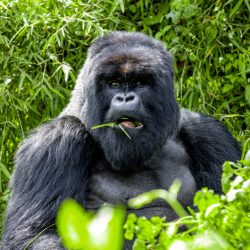Nshongyi Family Joins the Crowd
Blog | 30/09/09
The rain had not come in drops the night before, it came in torrents. Or, at least that was our impression as we pulled into Kabale, the southern Uganda town hugging Rwanda’s border that also serves as the IGCP Uganda Programme’s headquarters. As we snaked into town on a misty evening with heavy air and an eerie glow, massive sheets of water covering the roadways and fields glistened in the moonlight.
With the Land Cruiser splashing through the enormous puddles in the center of town, I heard some of my least favorite words, “You have to get up early tomorrow”. How early? “Well, we need to leave by 7 am at the latest.” Not too bad, considering my brain doesn’t click into gear before 8. And, the early start was worth it: IGCP was going to join our partners at the Uganda Wildlife Authority to welcome a new gorilla group named Nshongyi to the ranks of tourism. We were celebrating the group’s “graduation” of sorts. Tourists will now be able to experience Uganda’s largest habituated gorilla group, currently numbering 34, from tiny baby up to massive silverback.
Two of those massive silverbacks I know well enough. On a perfect March morning earlier this year, I was charged by them in rapid succession: 400 pounds X 2 of thick standing hair and enormous yellow teeth rumbling through the forest like dense ball of tropical thunder. We were the test subjects that day, working with UWA to ensure the Nshongyi brood became even more acclimated to their skinny next of kin. The silverbacks were likely just having some fun that day – showing us they still rule in their kingdom of plenty. They stopped a few meters short of our bunched up (and trembling) group, and just sauntered away in a casual stroll. One last lark before graduation.
The giant pools of water were already evaporating the next morning as we set out for the bustling mountain hamlet of Rubuguri, where the ceremony was to be held. Another perfect morning: blue sky coloring in the horizon directly on top of Bwindi’s endless rolling hills. It’s a gorgeous drive to Rubuguri, rocky roads teetering on the edge of the steep slopes challenging the vertical rise of beans, potatoes and corn stretching endlessly in a warm patchwork of fertility. I’ve been on this trip perhaps 20 times already, and I never tire of its beauty, and the smiling kids waiting with a wave and shout around every tight bend. As we approach the village, the stoic Virunga Volcanoes come into panoramic view, thrusting their pointy peeks through the last vestiges of morning fog.
Bumping down into Rubuguri, a giant square of white tents comes into view, contrasted by a sea of blue. These are the uniforms of the local school kids, who have come out in full force. It seems every student within a two day walk is here, and the smiling faces hit us even before we park. Under the tents are dignitaries, officials, community members and a handful of Hollywood actors, fresh from a gorilla tracking experience the day before. I notice Jason Biggs, the movie actor from the successful American Pie teen comedy series chatting with Gary Segal, the Manager of IGCP partner Clouds Mountain Gorilla Lodge.
The hot sun and a series of rousing speeches from the Director of the UWA, the Director of Tourism and a clutch of local dignitaries finally jolt me awake. As the local Batwa peoples prepare to jump and twist to the rhythmic drumming of their soaring traditional dance, a couple of dark birds, probably black kites, glide by overhead scanning the field. There will be no meals for them this morning, only a rousing party: when the MC tries to cut in for a presentation, the drums get louder and the Batwa keep up the pace. He finally gives in, swept up by the rhythm and moving crowd.
After the Hollywood actors receive gift bags with carved gorillas, we are in the mood to party again: the patient schoolchildren on the sidelines are let loose, dashing en masse to center stage in a blur of blue to be closer to their friends in the Nkuringo Orphans group, who jump into their dance with a kinetic energy not even the local actors roaming the grounds in gorilla suits can match. Gary, Clouds’ Manager, beams proudly. “That’s my group!” The Nkuringo orphans are one of the many groups who benefit from the Nkuringo Conservation Development Fund, a Clouds and IGCP assisted project helping to reduce human-gorilla conflict and build a sustainable future for local area families.
With the remaining energy that’s left there are congratulations and wishes for a better future, for both human and gorilla communities. The Nshongyi family are about to get more visitors, but I was sure they were paying no heed, tucked into a particularly lush patch of ripe forest on this day, munching roots, shoots and leaves contentedly, grabbing at the slivers of sun beaming through the tree canopy. They will now be peered upon by their less hairy cousins for an hour a day. Their small sacrifice of time, however, could lead to great rewards for all – harmony and the building of a sustainable, prosperous future. I would not presume to know their world or even guess if they were aware of these shifting dynamics. But I do know that I saw enough smiles and experienced enough hope and energy on this day to keep me moving for a long time to come. Moving with Nshongyi and moving with the people of Bwindi. All from this bright, simple ceremony. On yet another perfect morning again with teeth, but thankfully this time without the charging!





